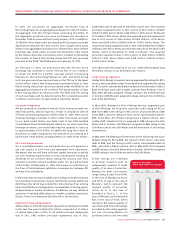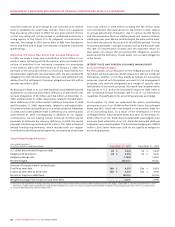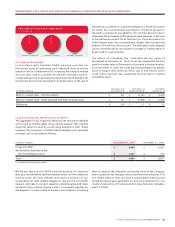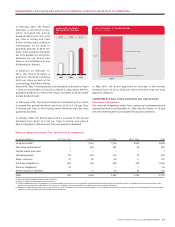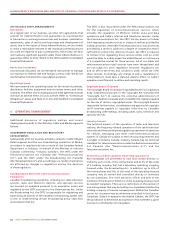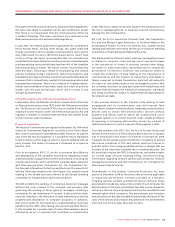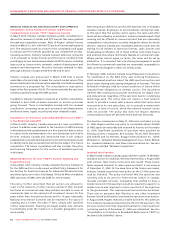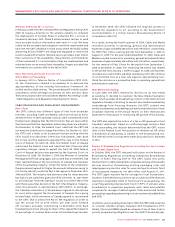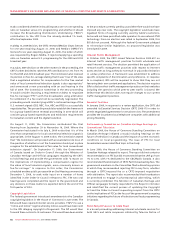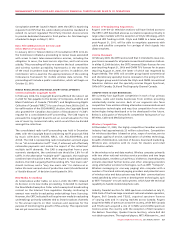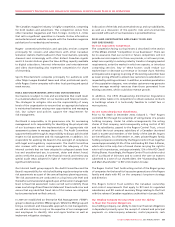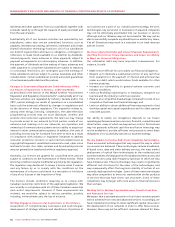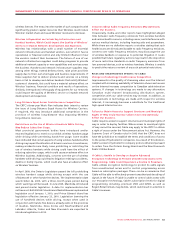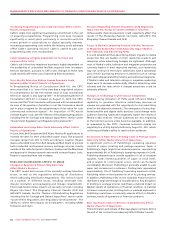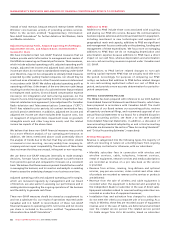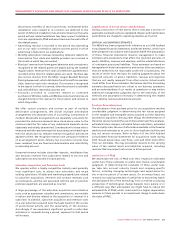Rogers 2009 Annual Report Download - page 53
Download and view the complete annual report
Please find page 53 of the 2009 Rogers annual report below. You can navigate through the pages in the report by either clicking on the pages listed below, or by using the keyword search tool below to find specific information within the annual report.
ROGERS COMMUNICATIONS INC. 2009 ANNUAL REPORT 57
MANAGEMENT’S DISCUSSION AND ANALYSIS OF FINANCIAL CONDITION AND RESULTS OF OPERATIONS
Consultation 2009-261 issued in March 2009, the CRTC is examining
requests from ISPs that the cable industry should be mandated to
extend its current regulated Third Party Internet Access service
to provide dedicated channels to third parties. An Oral Hearing is
scheduled to begin on May 31, 2010.
Basic Telecommunications Services and
Other Matters Proceeding
In January 2010 in Telecom Notice of Consultation CRTC 2010-43,
the Commission initiated a proceeding to review issues associated
with access to basic telecommunications services, including the
obligation to serve, the basic service objective, and local service
subsidy. This proceeding will also re-examine the local competition
and wireless number portability frameworks in the territories
of the small incumbent local exchange carriers. In addition, the
Commission will re-examine the appropriateness of the existing
forbearance framework for mobile wireless data services. The
proceeding will include a public consultation, which will begin on
October 25, 2010.
MEDIA REGULATION AND REGULATORY DEVELOPMENTS
Commercial Radio Copyright Tariffs
In February 2008, the Copyright Board reaffirmed the rates it set
in 2005 for fees payable to the Society of Composers, Authors and
Music Publishers of Canada (“SOCAN”) and Neighbouring Rights
Collective of Canada (“NRCC”) for use of music from 2003 to 2007. In
its reaffirmation of the SOCAN-NRCC decision, the Copyright Board
also granted the Canadian Association of Broadcasters’ (“CAB”)
request for a consolidated tariff proceeding. The CAB hopes to
persuade the Copyright Board to set an overall valuation for the
use of music by commercial radio, which would then be divided
amongst the collectives.
The consolidated radio tariff proceeding was held in December
2008, with the Copyright Board considering tariff proposals filed
by music collectives: SOCAN, NRCC, CSI, AVLA /SOPROQ, and
ArtistI. The CAB is representing radio broadcasters and will argue
for an “all-in broadcaster tariff” that, if achieved, will effectively
rationalize payments and reduce the impact of the collectives’
multiple tariff demands. The CAB is arguing that from a pure
economic standpoint, the combined rate should be 2.8% for all
tariffs. In the alternative “multiple tariff” approach, the maximum
combined rate should be 5.96%. With respect to talk-based radio
stations, the CAB is arguing that the existing 20% “low music rate”
should continue, and a “very low music rate” for stations at or
below 5% music use (exclusive of production music) should be set at
a “double discount”. A decision is anticipated in 2010.
New Media Proceeding
As noted above under Cable, on June 4, 2009, the CRTC released
its decision on its new media proceeding. It decided to maintain
the New Media Exemption Order which exempts all broadcasting
content on the Internet from regulation thereby continuing to
exempt new media broadcasting undertakings from licencing.
However, the CRTC indicated it will require new media broadcasting
undertakings (primarily websites tied to linear broadcast channels)
to file annual reports on their revenues and expenses for the
purpose of monitoring the growth of this activity. This requirement
has not yet come into effect.
Review of Broadcasting Regulations
Rogers’ over-the-air television stations will have limited access to
the CRTC’s LPIF described above as our stations operate primarily in
large urban markets with the exception of Citytv Winnipeg, which
received LPIF funding in 2009. Citytv and OMNI to a lesser extent,
post-August 31, 2011, will be able to negotiate payments with
cable and satellite companies for carriage of their signals into
distant markets.
Licence Renewals
In February 2009, the CRTC announced that it intended to issue one-
year licence renewals for all private conventional television stations.
In a May 15, 2009 decision, the CRTC renewed Citytv licences for one
year (expiring August 31, 2010) and OMNI TV’s licences for six years
(expiring August 31, 2015), the latter of which was requested by
Rogers Media. The CRTC will consider group-based (conventional
and discretionary specialty) licence renewals in the spring of 2010.
The Rogers group would include the Citytv and OMNI conventional
television stations and the specialty services Rogers Sportsnet,
G4TechTV Canada, OLN and The Biography Channel Canada.
COMPETITION IN OUR BUSINESSES
We currently face significant competition in each of our primary
wireless, cable and media businesses from entities providing
substantially similar services. Each of our segments also faces
competition from entities utilizing alternative communications and
transmission technologies and may face competition from other
technologies being developed or to be developed in the future.
Below is a discussion of the specific competition facing each of our
Wireless, Cable and Media businesses.
Wireless Competition
At December 31, 2009, the highly-competitive Canadian wireless
industry had approximately 23 million subscribers. Competition
for wireless subscribers is based on price, scope of services, service
coverage, quality of service, sophistication of wireless technology,
breadth of distribution, selection of devices, brand and marketing.
Wireless also competes with its rivals for dealers and retail
distribution outlets.
In the wireless voice and data market, Wireless competes primarily
with two other national wireless service providers and two large
regional players, resellers such as Primus, Vidéotron, impending new
entrants described further below and other emerging providers
using alternative wireless technologies, such as WiFi “hotspots”.
Wireless messaging (or one-way paging) also competes with a
number of local and national paging providers and potential users
of wireless voice and data systems may find their communications
needs satisfied by other current or development technologies, such
as WiFi “hotspots” or trunk radio systems, which have the technical
capability to handle mobile telephone calls.
Industry Canada’s auction for AWS spectrum concluded on July 21,
2008. Each of the three large incumbent national wireless operators,
Rogers, Bell Canada and TELUS, acquired spectrum licences
of varying sizes and in varying markets across Canada. Rogers
acquired 20 MHz of spectrum across the country, while Bell Canada
and TELUS each acquired a mix of 10 MHz and 20 MHz spectrum
licences across the country with the exception of Bell Canada in
the Eastern Townships, Quebec licence territory, where Bell did
not obtain spectrum. The regional players, MTS Allstream Inc., and


